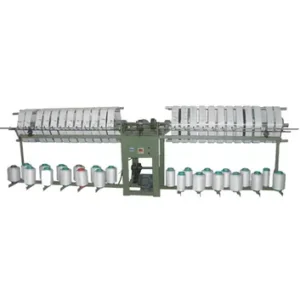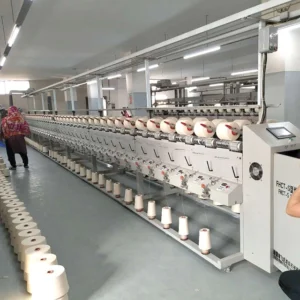The textile industry is one of the largest energy consumers globally, but shifting to renewable energy can reduce costs, improve sustainability, and meet growing consumer demand for eco-friendly products.
This guide explains how textile manufacturers can smoothly transition to clean energy sources while maintaining efficiency and profitability.
Why Should Textile Factories Switch to Renewable Energy?
Lower Energy Costs in the Long Run
While the upfront costs of installing solar panels or wind turbines may appear substantial, renewable energy systems typically pay for themselves within 3-7 years through energy savings.
Unlike fossil fuels that are subject to volatile market prices, renewables provide long-term price stability that makes budgeting easier.
Many factories find their overall operating costs decrease by 20-40% after transitioning to renewable power sources.
Meet Consumer Demand for Sustainable Products
Modern consumers increasingly check environmental credentials before making purchases, with 66% willing to pay more for sustainable products.
Textile brands using renewable energy can prominently display eco-certifications that appeal to this growing market segment.
Retailers like H&M and Zara now prioritize suppliers with verifiable green energy commitments in their sourcing decisions.
Compliance with Environmental Regulations
Governments are implementing stricter carbon taxes and emissions trading schemes that penalize heavy fossil fuel users.
The EU’s Carbon Border Adjustment Mechanism will soon impose fees on imported textiles based on their production carbon footprint.
Early adopters of renewables will avoid these penalties while qualifying for various green manufacturing incentives and tax breaks.
Future-Proofing the Business
As fossil fuel infrastructure ages and becomes more expensive to maintain, renewable energy systems are proving more reliable and cost-effective.
Factories investing now in solar, wind or biomass will be better positioned when carbon regulations inevitably tighten further.
This transition also future-proofs operations against potential fossil fuel supply chain disruptions.
Also Read:
- How Automation Equipment Facilitates Green Textile Production
- The Impact of Automation on Reducing Carbon Emissions in Textile Factories
- How to Conduct a Carbon Footprint Audit for Textile Factories
What Are the Best Renewable Energy Options for Textile Factories?
Solar Power for Consistent Energy Supply
Modern photovoltaic systems can now meet 40-60% of a textile factory’s energy needs, with the latest bifacial panels generating power from both sides for greater efficiency.
Solar is particularly advantageous for factories with large, unused rooftop spaces that can be converted into power generation assets.
When combined with lithium-ion battery storage, solar systems can provide stable power 24/7, overcoming the intermittency challenge.
Wind Energy for High-Energy Demands
For factories located in consistently windy areas (average speeds above 5m/s), a single modern wind turbine can generate enough electricity to power an entire mid-sized textile operation.
Wind works particularly well when paired with solar, as wind patterns often complement solar availability – stronger winds at night when solar isn’t producing.
Newer turbine designs operate quietly at lower wind speeds, making them suitable for more locations.
Biomass Energy for Waste-to-Power Solutions
Textile factories generate substantial organic waste from natural fibers like cotton, wool and silk that can fuel biomass generators.
Advanced gasification systems can convert 1 ton of textile waste into enough energy to power 20-30 sewing machines for a full day.
This circular approach not only provides renewable energy but also solves waste disposal challenges, creating a closed-loop system.
Hydropower for Water-Intensive Facilities
Textile dyeing and finishing mills located near rivers can install micro-hydro turbines that generate continuous baseline power from water flow.
Modern low-impact hydro systems require minimal infrastructure and can operate in waterways with as little as 2 meters of head.
Some factories are even retrofitting their existing water supply systems with in-pipe turbines to generate supplemental power.
How to Assess Energy Needs Before Transitioning?
Conduct an Energy Audit
A comprehensive energy audit conducted by certified professionals will map your factory’s complete energy footprint across all operations.
These audits typically identify 15-30% potential energy savings through equipment upgrades or process optimizations before even considering renewables.
Many energy service companies offer free preliminary audits with detailed reports showing payback periods for various improvements.
Analyze Peak Usage Times
Detailed analysis of your energy consumption patterns helps design a renewable system that matches your specific load profile.
For instance, factories with heavy daytime energy use would benefit most from solar, while 24/7 operations need hybrid systems with storage.
Smart meters and energy monitoring software can provide this data with granular 15-minute interval tracking.
Evaluate Available Space and Location
Solar potential assessments should consider roof load capacity, shading patterns, and orientation – south-facing roofs in the northern hemisphere yield optimal results.
Wind feasibility studies analyze local wind maps and turbulence patterns, while hydropower requires water flow rate and head measurements.
Geographic information system (GIS) tools can help visualize your site’s renewable energy potential.
What Financial Incentives Are Available?
Government Grants and Tax Credits
The U.S. Investment Tax Credit currently offers 30% back on solar installations, while many EU countries provide feed-in tariffs for renewable energy production.
Developing nations often have World Bank-funded programs offering 40-60% subsidies for clean energy transitions.
These incentives frequently stack, allowing factories to combine local, national and international support mechanisms.
Green Energy Loans and Leasing Options
Specialized green loans from development banks often feature below-market interest rates (3-5%) and extended repayment terms (7-10 years).
Power purchase agreements (PPAs) allow factories to host renewable systems owned by third parties, paying only for the energy produced.
Some leasing programs include maintenance and performance guarantees, transferring all technical risks to the provider.
Carbon Credit Programs
Factories can generate 1 carbon credit for every ton of CO2 reduced, currently valued at $10-50 in voluntary markets.
The Gold Standard and Verified Carbon Standard offer certification pathways specifically for industrial renewable energy projects.
Larger textile operations may qualify for cap-and-trade programs like the EU ETS where credits trade at premium prices.
How to Integrate Renewable Energy Without Disrupting Production?
Start with a Hybrid System
A phased approach that maintains your existing power infrastructure while gradually adding renewable capacity prevents production downtime during transition
Many factories begin by installing solar panels to cover 20-30% of daytime energy needs while keeping grid connections as backup.
This “test and scale” method allows operators to gain confidence in renewable performance before fully committing.
Implement Smart Energy Management Systems
Advanced energy management platforms use real-time data analytics to automatically shift between power sources based on availability and cost.
These systems can prioritize solar energy during peak daylight hours, switch to stored battery power in the evening, and only draw from the grid when absolutely necessary.
Some AI-powered solutions can predict energy needs 24 hours in advance based on production schedules and weather forecasts.
Train Employees on New Systems
Comprehensive training programs should cover both the technical aspects of the new equipment and the sustainability goals driving the change.
Hands-on workshops help maintenance staff understand the unique requirements of solar inverters, wind turbine controls, and battery storage systems.
Many renewable providers offer customized training packages along with their equipment installations.
What Are the Common Challenges and Solutions?
High Initial Investment Costs
The payback period for renewable systems has decreased significantly, with most solar installations now breaking even in 4-6 years.
Government incentives can cover 30-50% of upfront costs through tax credits, rebates, and accelerated depreciation benefits.
Some energy service companies offer “savings-guaranteed” contracts where they finance the installation and are paid from the energy cost reductions.
Intermittent Energy Supply
Modern lithium-ion battery systems can store enough energy to power operations through 8-12 hours of low generation.
Some factories install backup generators that run on biofuel as a sustainable alternative to diesel.
Grid-tied systems with net metering allow factories to “bank” excess renewable energy during productive periods for credit during low-production times.
Technical Expertise Requirements
Most reputable renewable energy providers offer comprehensive O&M (operations and maintenance) contracts for 5-10 years post-installation.
Industry associations like SEIA (Solar Energy Industries Association) provide certification programs to develop in-house expertise.
Many manufacturers find that partnering with local technical schools creates a pipeline of trained workers familiar with their specific systems.
How to Communicate the Change to Customers?
Highlight Sustainability in Marketing
Product tags and packaging can feature specific metrics like “Made with 50% solar energy” or “Carbon footprint reduced by 30%.”
Sustainability sections on your website should showcase your renewable installations with photos, videos, and real-time energy production dashboards.
Consider applying for recognized eco-certifications that resonate with your target markets and distribution channels.
Share Progress Through Transparency Reports
Annual sustainability reports should include verifiable data on renewable energy percentage, emission reductions, and future goals.
Interactive web tools can allow customers to calculate the environmental impact of their specific purchases.
Some brands include QR codes on products that link to detailed information about the renewable energy used in their production.
Educate Consumers on the Benefits
Customer education campaigns can explain how renewable-powered production results in cleaner manufacturing processes with fewer air pollutants.
Highlight the long-term quality benefits – fabrics produced with renewable energy often have more consistent coloration and fiber integrity.
Consider hosting virtual factory tours or “sustainability days” to showcase your renewable energy investments to buyers and journalists.
And More:
- Top 10 Small CNC Winding Machine Manufacturers in China
- Ways to Achieve Carbon Neutrality in the Textile Industry
Conclusion
Transitioning to renewable energy in textile production is no longer just an environmental choice—it’s a smart business strategy.
By assessing energy needs, leveraging financial incentives, and integrating the right mix of solar, wind, or biomass power, factories can cut costs, comply with regulations, and appeal to sustainability-driven customers.
The shift may require planning, but the long-term benefits make it a worthwhile investment for any forward-thinking textile manufacturer.











